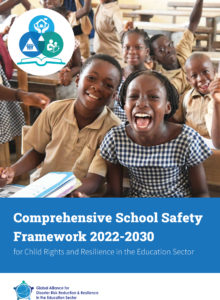Update and Launch of the Comprehensive School Safety Framework


CE International is deeply aware that school safety is a critical component of a child’s well-being. When children feel safe, they are able to focus on learning because they know they are in a stable and secure environment. When they feel safe, they are able to engage in healthy social relationships and develop friendships. Well-being is one of CE International’s three core Practice Areas and so we are pleased to announce the release of a newly updated Comprehensive School Safety Framework.
The Global Alliance for Disaster Risk Reduction & Resilience in the Education Sector has revamped its school safety framework in order to build the collaboration and collective impact of humanitarian and development stakeholders in education-related planning processes. With the effects of COVID-19 and an increase in risks, natural disasters, and negative consequences of climate change, school safety is of an upmost priority. Launched on 12 September 2022, the Comprehensive School Safety Framework 2022-2030 for Child Rights and Resilience in the Education Sector will provide guidance to school system actors and partners so that they can ensure education is safe, equitable, and continuous for everyone. It considers all hazards, risks, and everyday threats and aligns its foundation and pillars to the Sustainable Development Goals (SDGs).
 Setting the foundation for enabling systems and policies, the framework speaks to three pillars that we need to create and strategize:
Setting the foundation for enabling systems and policies, the framework speaks to three pillars that we need to create and strategize:
By outlining who is responsible as duty bearers and what actions and strategies are needed within each pillar, the framework demonstrates that children’s rights will be protected and their resilience increased. At the launch, intergovernmental and NGO leads, MoE representatives, and student activists advocated for the framework and the need for all school systems to protect and ensure the safety and continuity of everyone’s education.
The framework has been adopted and adapted by education authorities in more than 60 countries, and regional intergovernmental organizations in Asia, the Pacific, Latin America, and the Caribbean.